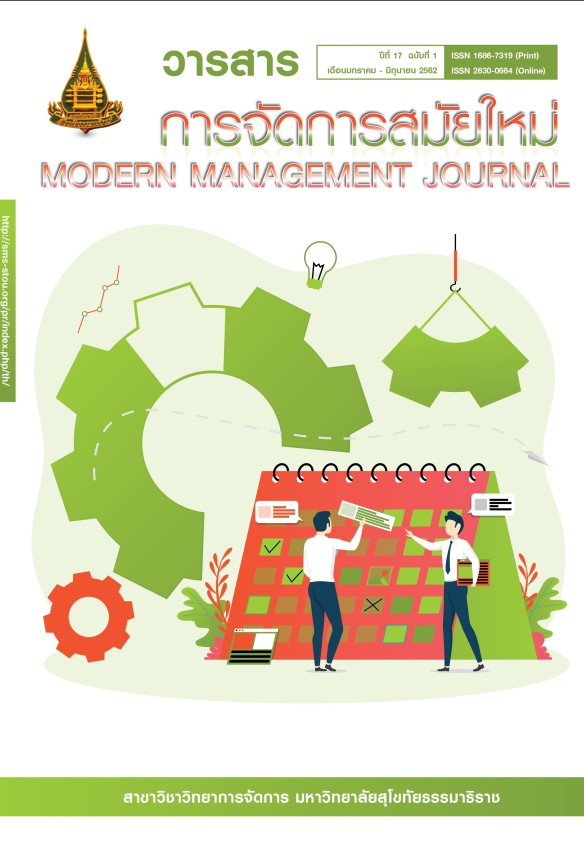THE FACTORS AFFECTING BRAND AWARENESS OF PRIVATE HIGHER EDUCATION INSTITUTIONS IN THE CONTEXT OF SOCIAL MEDIA OF VOCATIONAL EDUCATION LEVEL STUDENTS IN SAMUTPRAKARN PROVINCE
Keywords:
Brand Awareness, Private Higher Education Institutions, Social Media, Vocational Education Level StudentsAbstract
The objectives of this research were: 1) to study and to analyze the factors affecting brand awareness of private higher education institutions in the context of social media of vocational education level students in Samutprakarn province, and 2) to applied the results of this research into practical use for formulating policy and brand awareness strategic plan of private higher education institutions in the context of social media for building brand awareness, brand equity, and brand positioning into vocational education level students.
This research began from reviewing literature on the factors affecting brand awareness of private higher education institutions in the context of social media with review literatures for formulating conceptual framework and employed hypotheses, emphasized a quantitative research technique. A mail survey was conducted to sample of 400 students as samples in Samutprakarn province. A descriptive statistics used was percentage and an analytic statistic was multiple regressions in the study. The tentative evidences from the study suggest that the main factors that affect brand awareness of private higher education institutions in the context of social media include customer engagement, e-words of mouth communications, brand exposure, brand attitudes and brand values.
References
Bryman, A. (1996). Business Research Methods. Oxford, United Kingdom: Oxford University Press.
Bond, C. (2010). Engagement with social and outcomes for brands: A conceptual framework. ANZMAC Annual Conference 2010, Christchurch, New Zealand.
Cochran, W.G. (2007). Sampling techniques (3rd ed.). New York: John Wiley & Sons.
Cornwell, T. B., Relyea, G. E., Irwin, R. L., & Maignan, I. (2000). Understanding long-term effects of sports sponsorship: Role of experience, involvement and enthusiasm. International Journal of Sports &Sponsorship, 2(2), 127-142.
Farrar, Donald E., & Glauber, Robert R. (1967). Multicollinearity in Regression Analysis: The Problem Revisited. Review of Economics and Statistics, 49(1), 92–107. JSTOR 1937887.
Haven, B., Bernoff, J., & Glass, S. (2007). Marketing’s new key metric. Engagement: Forrester Research. Inc.
Howitt, D., & Cramer, D. (2001). A Guide to Computing Statistics: with SPSS for Windows. London: Prentice Hall
Hollebeek, L. D. (2011). Demystifying customer brand engagement: exploring the loyalty nexus. Marketing Management Journal, 27(7/8), 785-807.
Ingaj, A., & Sutthiudom, C. (2006). Factors affecting students' decision making Diploma level in undergraduate education in Private higher education institutions: a case study in Bangkok. BU Academic Review, 5(2), 24-37. [in Thai]
Laroche, M., Kim, C., & Zhou, L. (1996). Brand familiarity and confidence as determinants of purchase intention: An empirical test in a multiple brand context. Business Research Journal, 37(2),115-120.
Nunnally, J. C. (1978). Psychometric Theory (2nd ed.). New York: McGraw-Hill.
Newman,W.L. (1997). Social Research Methods. Boston: Allyn and Bacon.
Office of the Promotion of Learning and Youth Quality Society. (2015). Information about Open the case of
education. Retrieved from http://www.qlf.or.th/Home/Contents/741
Pitts, B. G., & Slattery, J. (2004). An examination of the effect of time on sponsorship awareness levels. Sport Marketing Quarterly Journal, 13, 43-54.
Ryan, D., & Jones, C. (2011). Best Digital Marketing Campaigns in the World: Mastering The Art of Customer Engagement. Kogan Page
Shojaee, S., & Azman, A. B. (2013). An Evaluation of Factors Affecting Brand Awareness in the Context of Social Media in Malaysia. Asian Social Science, 9(17), 72-78.
Sashi, C. M. (2012). Customer engagement, buyer-seller relationships, and social media. Management Decision, 50(2), 253-272.'
Shim, J. K. (2000). Strategic business forecasting: The complete guide to forecasting real world company performance. CRC Press.
Weber, L. (2009). Marketing to the Social Web: How digital customer communities build your business. Hoboken, New Jersey: John Wiley and Sons. Inc..
Westbrook, R.A. (1987). Product Consumption based effective response and post purchase processes. Journal of Marketing Research, 24, 258–270.



